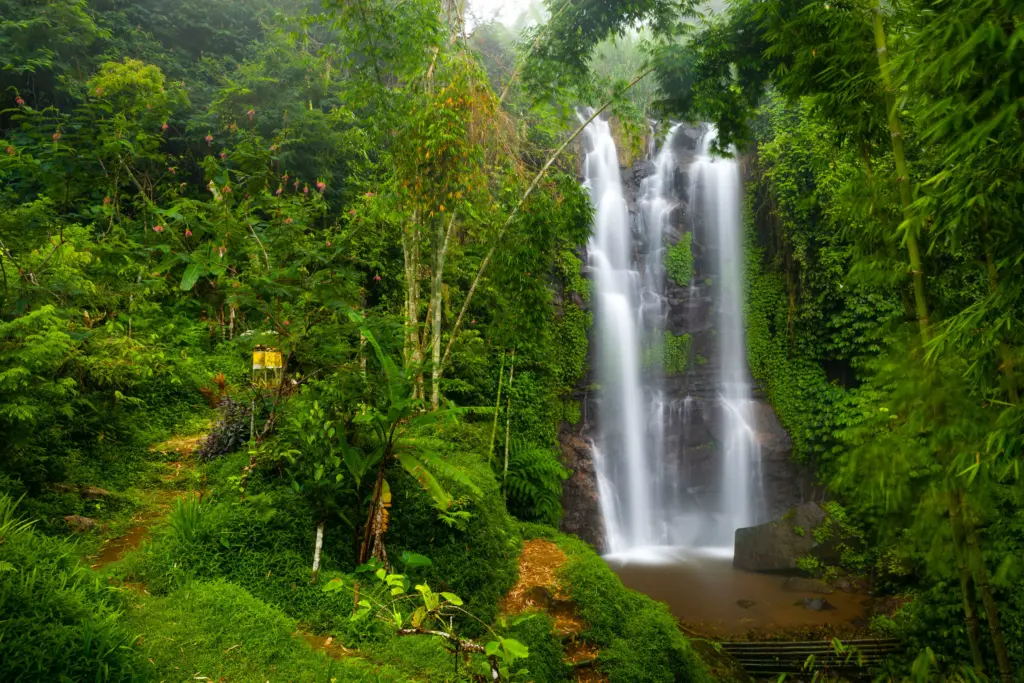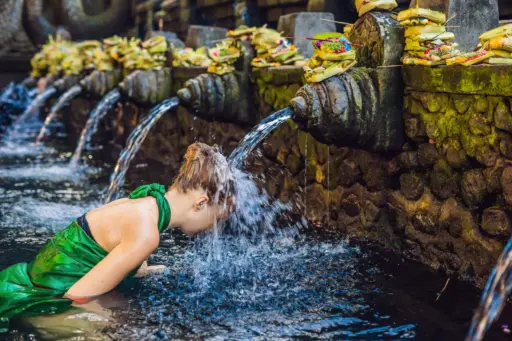For all its temples, beaches, and rice terraces, Bali’s waterfalls hold a different kind of magic. They are tucked in green ravines, hidden behind jungle paths, and surrounded by the sounds of rushing water and birdsong. Some are dramatic torrents, others gentle streams, but each has a soul of its own – a sense of energy that comes not just from the falling water but from the way Balinese culture weaves spirituality into the land itself.
Here is a guide to Bali’s five most soulful waterfalls, each offering not just a beautiful sight, but a chance to slow down, breathe, and connect with the island’s deeper rhythms.
Tegenungan Waterfall – A Classic with a Local Heart
Located in Kemenuh village, just south of Ubud, Tegenungan is one of Bali’s most famous waterfalls, and for good reason. It is powerful, accessible, and framed by lush greenery. Yet what makes it soulful is not just the size of the falls, but the way it is tied to local life.
From Ubud, it is only a 20-minute drive, and from Denpasar, about 30–40 minutes. The road winds past rice paddies and small warungs before arriving at the parking area. From there, a short walk down stone steps leads to your first glimpse of the cascade. The sound grows louder as you descend, and by the time you reach the riverbank, the waterfall’s spray is in the air.
Tegenungan drops from about 15 metres into a broad, rocky pool. During the dry season, the water is clear enough for swimming, and there is a shallow area where you can wade. In the wet season, the falls swell dramatically – beautiful but less safe for swimming.
Above the main cascade, small platforms and viewpoints give sweeping views of the river valley. One spot has a swing and photo deck, popular with visitors but easy to skip if you prefer the natural feel.
Facilities are better here than at most Bali waterfalls. There are cafés with river views, toilets, changing rooms, and even small shops selling drinks and snacks. The entry fee is modest, and parking is straightforward. The best times to visit are early morning for softer light and fewer crowds, or late afternoon when the sun filters through the trees.
Tegenungan may be well known, but it still holds a sense of connection – especially if you linger by the water after most visitors have left, letting the sound of the falls fill the space around you.
Sekumpul Waterfall – The Island’s Most Majestic Drop
In the hills of North Bali, deep in Buleleng Regency, lies Sekumpul, a place many call the most beautiful waterfall on the island. It is not just one fall, but a cluster of seven, spilling down from different heights into a lush valley. The tallest drops over 80 metres, sending mist into the air like a natural veil.
Getting here takes commitment. From Ubud, allow around 2.5–3 hours by car, and from Lovina, about 45 minutes. The road winds into the mountains, through clove plantations and quiet villages. At the parking area, a local guide is usually required – partly for safety, partly to ensure the community benefits from tourism.
The trek down to Sekumpul takes about 30–40 minutes and involves steep steps, river crossings, and narrow jungle paths. Along the way, you will hear the waterfalls before you see them. When you finally emerge at the base, the sight is overwhelming – twin columns of water thundering into the pool below, framed by deep green cliffs.
Swimming is possible in the lower pools, though the current near the base can be strong. Many visitors choose to stand at the edge, letting the mist soak their skin. The air here is cooler, scented with wet leaves and earth, and the sound of the falls is almost meditative.
Facilities are basic – there are small warungs near the start of the trail, and toilets at the top – but the real value of Sekumpul lies in its wildness. It is a place that demands effort to reach, rewarding you with a view that feels untouched and humbling.
Nungnung Waterfall – Power and Solitude in the Highlands
Halfway between Ubud and Bedugul, tucked in the highlands of Petang, lies Nungnung Waterfall. At 900 metres above sea level, the air here is fresh and cool, and the waterfall is one of the most powerful in Bali. It drops a roaring 50 metres into a misty pool, surrounded by moss-covered walls.
From Ubud, the drive takes about an hour; from Denpasar, a little more. The road climbs through farmland, with views over valleys and rice terraces. At the entrance, you pay a small fee before beginning the descent – over 500 steep steps down to the river. It is a workout, but the first sight of the falls makes it worth every step.
Nungnung is loud, constant, and utterly captivating. The spray can drench you from several metres away, and rainbows often form in the mist. Swimming is possible in the calmer edges of the pool, but the force of the main drop is intense, and caution is essential.
Unlike more famous waterfalls, Nungnung is often quiet. You might share it with just a few other travellers, especially in the early morning. There are no cafés or shops here – just the sound of water, the smell of damp earth, and the cool air on your skin.
The climb back up is steep, so take your time and bring water. For those who make the effort, Nungnung offers a raw, elemental experience – a reminder of how small we are beside nature’s power.
Tibumana Waterfall – A Hidden Gem Close to Ubud
If you are looking for a waterfall with a softer, more intimate feel, Tibumana, in Bangli Regency, is a perfect choice. It is just 30 minutes from Ubud, yet feels like a hidden retreat.
The drive from Ubud winds through small villages and rice paddies, with coconut palms arching over the road. At the parking area, the path to the waterfall is short and easy, crossing a small bridge and passing through dense greenery.
Tibumana drops in a single straight column into a wide, calm pool, perfect for swimming. The water is cool but not cold, and the sandy bottom makes it comfortable to wade. The surrounding rock walls are draped in vines, and the setting feels enclosed and peaceful – more like a private sanctuary than a tourist site.
The name Tibumana is linked to local legends, and the area is considered spiritually significant. The falls are sometimes closed for ceremonies, so it is worth checking before you go. Facilities include small warungs, toilets, and changing rooms, and the entry fee is minimal.
Come early in the morning, and you might have the place almost to yourself, with nothing but the sound of falling water and birds in the trees above. It is a reminder that beauty does not have to be grand to be soulful.
Gitgit Waterfall – A Northern Classic with Cultural Roots
One of Bali’s most accessible and well-known waterfalls, Gitgit lies in the hills between Singaraja and Bedugul. It has been welcoming visitors for decades, and while it is no longer a secret, it still holds cultural and natural appeal.
From Lovina, it is just a 20-minute drive, and from Ubud, about two hours. The path from the parking area is well-marked and takes around 15 minutes to walk. Along the way, you will pass small stalls selling souvenirs, drinks, and snacks.
Gitgit actually consists of several falls in the area, but the main drop is a narrow, elegant stream that falls about 35 metres into a clear pool. The setting is lush, with ferns and flowers lining the path.
The water here is considered holy by locals, and ceremonies are sometimes held nearby. Swimming is possible, though the pool is smaller than at some other falls. The easy access makes it a good stop for travellers exploring the north, and the surrounding area offers other attractions like the twin lakes and Buddhist temples.
Despite its popularity, Gitgit still carries a sense of tradition. Guides are often available to explain the cultural significance of the site, and if you wander just a little farther, you may find quieter corners away from the main path.
Finding Your Own Connection
Bali’s waterfalls are more than just photo stops. Each has its own rhythm and atmosphere – whether it is the raw force of Nungnung, the towering beauty of Sekumpul, or the gentle calm of Tibumana. Visiting them is not just about seeing water fall over rock; it is about stepping into places where nature and culture meet, where the island’s spirituality is felt in the cool air, the sound of rushing water, and the way locals treat these places with quiet respect.
If you plan to visit more than one, consider spacing them over several days. Each deserves time to linger, to listen, and to feel. Bring water shoes or sandals with good grip, carry a change of clothes, and always respect safety signs – Bali’s waterfalls are beautiful, but they are also wild.
Above all, go with the mindset of a guest. These are places that locals have visited for generations, not just attractions for visitors. Leave them as you found them, and you will take away more than photos – you will carry a little of their soul with you.




